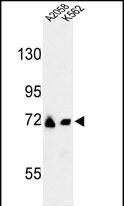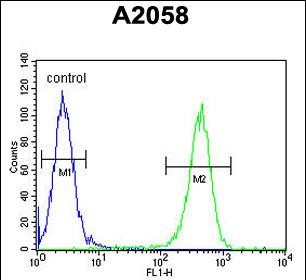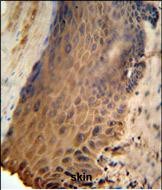


| WB | 1/1000 | Human,Mouse,Rat |
| IF | 咨询技术 | Human,Mouse,Rat |
| IHC | 1/100-1/500 | Human,Mouse,Rat |
| ICC | 技术咨询 | Human,Mouse,Rat |
| FCM | 1/10-1/50 | Human,Mouse,Rat |
| Elisa | 咨询技术 | Human,Mouse,Rat |
| Aliases | Glutamine--fructose-6-phosphate aminotransferase [isomerizing] 2, D-fructose-6-phosphate amidotransferase 2, Glutamine:fructose-6-phosphate amidotransferase 2, GFAT 2, GFAT2, Hexosephosphate aminotransferase 2, GFPT2 |
| Entrez GeneID | 9945 |
| WB Predicted band size | 76.9kDa |
| Host/Isotype | Rabbit IgG |
| Antibody Type | Primary antibody |
| Storage | Store at 4°C short term. Aliquot and store at -20°C long term. Avoid freeze/thaw cycles. |
| Species Reactivity | Human |
| Immunogen | This GFPT2 antibody is generated from rabbits immunized with a KLH conjugated synthetic peptide between 175-201 amino acids from the Central region of human GFPT2. |
| Formulation | Purified antibody in PBS with 0.05% sodium azide. |
+ +
以下是关于GFPT2抗体的3篇参考文献的简要总结:
---
1. **文献名称**:*"GFPT2 overexpression promotes malignant transformation in multiple myeloma via aberrant protein O-GlcNAcylation"*
**作者**:Li, Z., et al.
**摘要**:该研究通过免疫组化(使用GFPT2特异性抗体)发现,多发性骨髓瘤中GFPT2表达显著升高,其通过增强蛋白质O-GlcNAc糖基化促进肿瘤细胞增殖和化疗抵抗。
---
2. **文献名称**:*"Antibody-based detection of GFPT2 in diabetic nephropathy: implications for renal fibrosis"*
**作者**:Wang, Y., et al.
**摘要**:研究者利用GFPT2抗体进行Western blot和免疫荧光分析,证实糖尿病肾病模型中GFPT2在肾脏组织中的上调与纤维化通路激活相关,提示其作为治疗靶点的潜力。
---
3. **文献名称**:*"Development and validation of a high-specificity GFPT2 monoclonal antibody for cancer biomarker studies"*
**作者**:Sato, K., et al.
**摘要**:本文报道了一种新型GFPT2单克隆抗体的开发,通过ELISA和免疫组化验证其特异性,并应用于胃癌组织样本检测,发现GFPT2高表达与患者预后不良相关。
---
以上文献涵盖了GFPT2抗体在疾病机制研究、诊断应用及抗体开发中的具体案例。如需获取全文,建议通过PubMed或ResearchGate平台检索标题。
The GFPT2 antibody is a crucial tool for studying glutamine:fructose-6-phosphate amidotransferase 2 (GFPT2), a rate-limiting enzyme in the hexosamine biosynthesis pathway (HBP). This pathway generates uridine diphosphate N-acetylglucosamine (UDP-GlcNAc), a substrate for protein O-GlcNAcylation—a post-translational modification involved in cellular signaling, stress response, and gene regulation. GFPT2. one of two GFPT isoforms (GFPT1 and GFPT2), is predominantly expressed in muscle and neuronal tissues. It catalyzes the conversion of fructose-6-phosphate to glucosamine-6-phosphate, initiating HBP flux. Dysregulation of GFPT2 has been implicated in metabolic disorders, muscular pathologies, and neurodegenerative diseases, with altered O-GlcNAcylation linked to insulin resistance, cancer progression, and tau hyperphosphorylation in Alzheimer’s disease.
GFPT2 antibodies enable detection and quantification of GFPT2 protein levels in tissues and cell lysates via techniques like Western blotting, immunohistochemistry, and immunofluorescence. These antibodies are pivotal in exploring GFPT2’s tissue-specific roles, particularly in neuromuscular junctions and glucose metabolism. Commercially available GFPT2 antibodies are typically raised against conserved epitopes, with validation across species (human, mouse, rat). Researchers utilize them to investigate GFPT2’s interplay with insulin signaling, its overexpression in diabetic conditions, and its potential as a therapeutic target. Specificity validation via knockout controls remains essential, as cross-reactivity with GFPT1 may occur due to sequence homology. Ongoing studies leverage these antibodies to dissect HBP’s role in cellular nutrient sensing and disease mechanisms.
×